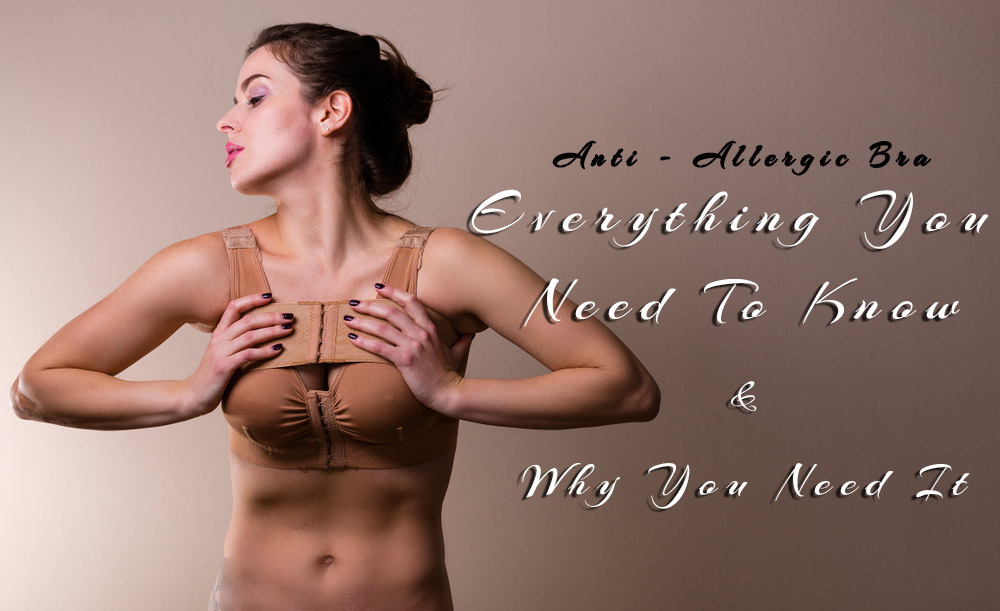No products in the cart.

Anti- Allergic Bra – Everything You Need To Know & Why You Need It
Itchy breasts and allergies can be such a frustration more so because breasts are exposed to a variety of potential triggers daily. These include sweat, friction, cyclical hormone changes, and bra-related problems. Of course, it’s expected that once in a while, you will have itchy skin (arms, legs) and that’s usually no big deal. But itchy boobs? No one wants that!
The skin fold beneath the breast is a warm, shaded, moist area which means that it’s an environment where germs can grow leading to fungal skin infections. Most root causes of breast allergies are directly related to the type of bra. If your body is not resistant to the metal or the elastic used in making the bra, you will be bombarded with rashes and skin irritation around the breasts.
Let’s look fully into why bras can be allergic and the causes of itchy breasts
Bra underwires or front clasps may contain nickel. According to research carried out by the Mayo Clinic, nickel allergy is one of the most common causes of allergies that appears when your skin touches a harmless substance. This allergy comes in the form of a rash and will normally appear within 12 to 48 hours after wearing your bra and could last two to four weeks. A nickel allergy rash causes painful little bumps on the skin, severe itching, and redness. If you developed a rash after switching to a bra with underwires or the fabric covering your underwires is wearing thin, you could be having an allergic reaction to nickel.
Also, if the bra clips (clasps) are made of nickel and your skin is allergic to it, you will have bra allergies. The symptoms are, the skin will become itchy, turn red, blisters and even bleed in the worst situations.
Latex allergy
A latex allergy occurs when your body’s immune system overreacts to certain kinds of proteins found in natural rubber latex that’s used to make things like bras, rubber gloves, bandages, computer mouse pads, clothing including elastic underwears, have latex material in them. Though latex allergies have been diagnosed for decades, there is no specific treatment or complete cure other than prevention.
Bra elastics are made of latex, therefore, if your skin is not resistant to latex and if you have sensitive skin that protests at the slightest hint of certain fabrics, you will suffer from allergic reactions like rashes, bulbs, dryness, itching, burning, scaling, and lesions of the skin. It’s important to know that the reaction is more severe if it spreads and lasts longer.
Yeast Infection
The skin underneath and on the sides of the breasts can become moist, allowing an overgrowth of yeast that can cause itching.
A yeast infection can cause a shiny red rash either in the skin folds underneath and around the breasts or on the nipples. As with yeast infections in other parts of the body, a yeast infection on the breasts will cause the following symptoms: itching, burning, pain, patches of small round bumps, blisters or pustules that contain foul-smelling pus
To prevent yeast growth under the breasts, it helps to wear bras that are made of a breathable fabric, like cotton. Wearing a comfortable and supportive bra, even during sleep, can prevent skin folds from trapping sweat and moisture.
After showering, make sure that the area under your breasts is completely dry before putting on a bra. If you work out, be sure to select an anti-allergic bra that’s made of fabric that keeps sweat and moisture away from the skin.
You have dry skin
We’d be making a mistake not to mention this one. Yes, dry skin could be the reason you have itchy boobs. Dry skin anywhere on the body can cause itching, breasts not excluded. If you’re prone to dry skin, be sure to keep your breasts moisturized always.
What to do then
Like many other allergies, the best way to get rid of it is to stay away from what causes it. But, can you think of being without your bra? I guess not! Here is a solution to get rid of bra allergies.
The most important solution is to use bras that do not have latex in them. Cotton bras with cotton adjustable straps are ideal. The other solution would be to insert a piece of cloth under the elastic part of the bra but you’d agree that all this stuffing would look weird. Alternatively, you can wear a medical alert bracelet, key chain or necklace that will immediately alert you whenever you come in contact with latex.
The beauty that’s an anti-allergic bra
Wearing lightweight bras and undergarments can help keep the skin of your breasts cool, lowering your risk of developing a rash. Anti-allergic bras are made without latex, nylon or nickel and use only allergy-safe dyes to ensure lasting comfort without irritation. The bralette shape provides basic support without the discomfort of an underwire and provides great relief for bra line eczema, rashes and bumps and nipple eczema.
Anti-allergic bras are perfect for both overnight or during the day usage under clothing for combating sensitive skin, eczema and psoriasis issues.
Anti-allergic bras are spandex-free, and this chemical-free design is bolstered with hypoallergenic plastic clips that secure you upfront, keeping sensitive skin safe from allergic reactions. Anti-allergic bras are ideal for Sensitive Skin, Latex Allergy, Dermatitis, Textile Dye Dermatitis, Eczema and Psoriasis.
An invisible itch on any part of your skin, including your breasts, can be difficult to overlook. However, it’s most likely coming from simple irritation of the skin, dry skin, or discomfort from your bras. The tips above will give you all the insight into itchy breasts and anti-allergic bras.






Leave a Reply